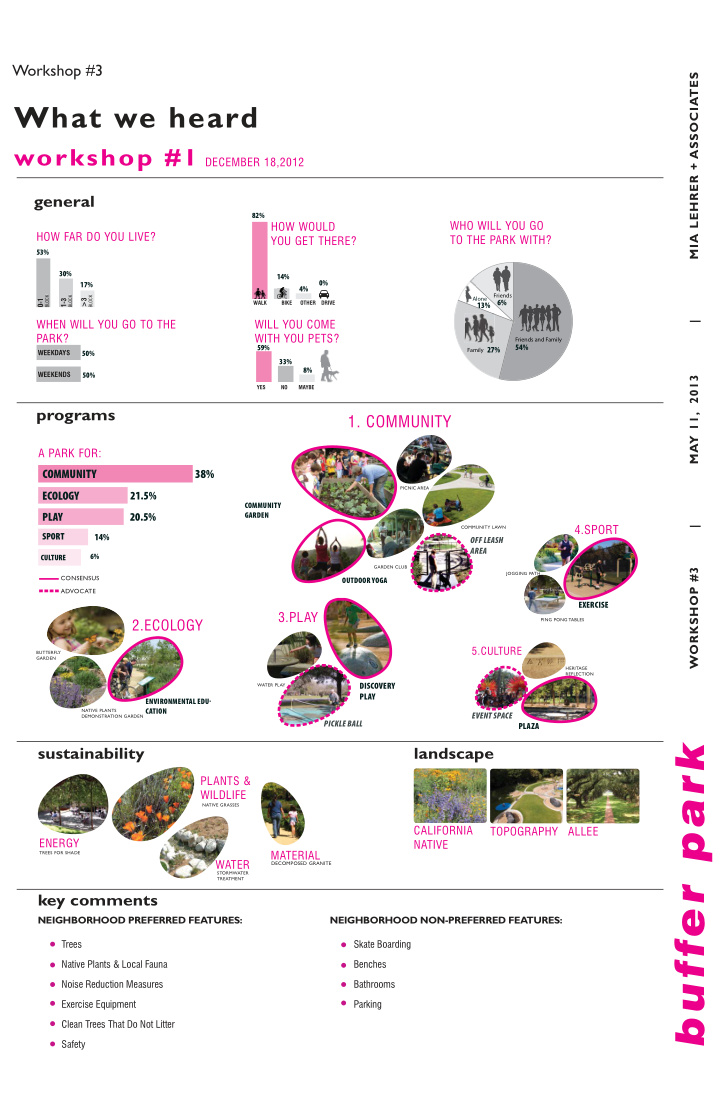



Workshop #3 WORKSHOP #3 | MAY 11, 2013 | MIA LEHRER + ASSOCIATES What we heard workshop #1 DECEMBER 18,2012 general 82% HOW WOULD WHO WILL YOU GO HOW FAR DO YOU LIVE? TO THE PARK WITH? YOU GET THERE? 53% 30% 14% 0% 17% 4% Friends BLOCK BLOCK BLOCK Alone 0-1 1-3 >3 6% WALK BIKE OTHER DRIVE 13% WHEN WILL YOU GO TO THE WILL YOU COME PARK? WITH YOU PETS? Friends and Family 54% 59% 27% Family WEEKDAYS 50% 33% 8% WEEKENDS 50% YES NO MAYBE programs 1. COMMUNITY A PARK FOR: COMMUNITY 38% PICNIC AREA ECOLOGY 21.5% COMMUNITY PLAY 20.5% GARDEN COMMUNITY LAWN 4.SPORT SPORT 14% OFF LEASH AREA 6% CULTURE GARDEN CLUB JOGGING PAT P H CONSENSUS OUTDOOR YOGA ADVOCATE EXERCISE 3.PLAY PING PONG TABLES 2.ECOLOGY 5.CULTURE BUTTERFLY GARDEN HERITAGE REFLECTION DISCOVERY WATER PLAY A PLAY ENVIRONMENTAL EDU- CATION NATIVE PLANTS EVENT SPACE DEMONSTRATION GARDEN PICKLE BALL PLAZA buffer park sustainability landscape PLANTS & WILDLIFE NATIVE GRASSES CALIFORNIA TOPOGRAPHY ALLEE ENERGY NATIVE TREES FOR SHADE MATERIAL WATER DECOMPOSED GRANITE STORMWATER TREATMENT key comments NEIGHBORHOOD PREFERRED FEATURES: NEIGHBORHOOD NON-PREFERRED FEATURES: Trees Skate Boarding Native Plants & Local Fauna Benches Noise Reduction Measures Bathrooms Exercise Equipment Parking Clean Trees That Do Not Litter Safety
Workshop #3 WORKSHOP #3 | MAY 11, 2013 | MIA LEHRER + ASSOCIATES What we heard workshop #2 MARCH 6, 2013 layouts TABLE #1 TABLE #2 comments TABLE #1 Exercise equipment incorporated into a “looping” trail system (10-15 equipment spaces around edge) Play next to Gather for people to a place to watch and relax while kid’s play Pathways between allees of trees Preference for an unconventional sidewalk 10’ sidewalk seems too large Plant low planting around play areas Concerns about the width variation throughout park Learning Garden instead of a Community Garden (precedents in Inglewood, CA) What does the sound wall look like? Screening the maintenance yard as much as possible TABLE #2 Community Garden called Learning Garden with food preparation area buffer park Suggest gathering space at end of Yorkshire (on axis) Play and Learning Garden at Dorchester Some buffer trees along Stewart Don’t want park to be inviting to more people - should be about buffering - no school tours Materials: high trees, bamboo, granite No big dog park / small dog park or none at all (suggested at Dorchester) Small exercise area - linear path with equipment points Discovery Play next to Gather Check on BBQs Bouldering and grading to create topography Bike racks #1 Priority is buffering along Maintenance Yard to mitigate noise and filter dust - Bamboo suggested as plant material Amenities are secondary 75% of this project should be about blocking negatives from Maintenance Yard Winding path with varying widths - narrow in narrow points and wider in wider points If ficus trees are used do so along street so half the litter falls on street No concrete sidewalk
Workshop #3 WORKSHOP #3 | MAY 11, 2013 | MIA LEHRER + ASSOCIATES A park for: 1. buffer TOPOGRAPHY VISUAL upper garden tree canopy lower garden bird tower 2. sustainability WATER BIODIVERSITY watershed garden bird sanctuary water filtration polinator orchard 3. community LEARN GATHER demonstration garden community pavillons garden lab flexible plaza buffer park 4. exercise EXERCISE 0.5 mile jogging path 0.25 mile jogging path exercise stations
Workshop #3 WORKSHOP #3 | MAY 11, 2013 | MIA LEHRER + ASSOCIATES A learning garden #1 polinator #2 orchard #1- THE DEMONSTRATION GARDEN OPTION A AN ETHNOBOTANY GARDEN Identify traditional use of plants by specific cultures. Examples: - Aloe - Sage - Lavender CALIFORNIA PLANTING COMMUNITIES GARDEN OPTION B Learn about the california planting community: - Mountain - Meadow - Coastal scrub #2- THE GARDEN LAB A POLINATOR ORCHARD GROWING BEDS buffer park HOW IT MIGHT WORK - A bi-annual or quarterly gardener would be in charge of programming the garden with the City and the community and work on plant material selection. This could be a community member, a master gardener, a farmer, an artist, a non-profit organization etc...One concept would be to have master “farmers” grow, manage, maintain the garden for a fixed period of time. As part of this concept the master farmer would provide a limited number of gardening/ raw cooking classes to the community helping them to implement the concepts of the learning garden into their own backyards. - The community would participate in the community events, participate in planting, picking and maintenance days. - Extra fruit would be harvested by an organization such as “food forward” or “fallen fruit” and donated to a non-profit or food bank. The Community (neighborhood) will have an opportunity to harvest fruit for their use prior to the organization’s assistance with the fruit harvesting. - The garden could be fenced if necessary
Recommend
More recommend